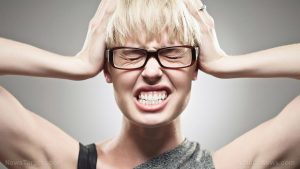
Cluster headaches – causes, side effects and treatments at NaturalPedia.com
Thursday, February 22, 2018 by Ralph Flores
http://www.naturalpedia.com/cluster-headaches-causes-side-effects-and-treatments-at-naturalpedia-com.html

Cluster headaches (CH, also referred to as histamine headaches) belong to a rare primary headache disorder that affects only one side of the head. People who have CH experience a grouping of headaches that may occur for a period of several weeks, with periods lasting anywhere from 15 to 180 minutes a day to even eight CH attacks a day. After the cluster period, the headaches disappear for months or even years – only to return at a later date.
The disorder may be classified into two types:
- Episodic CH, where a person has a cluster period that lasts from seven days to a year, which is separated by a CH-free period that lasts a month or longer
- Chronic CH, where a person experiences more than one cluster period in a year, with a CH-free interval of less than a month
CH is one of the most excruciatingly painful headaches known to man – it’s so severe, that 15 to 22 percent of people who suffer from it have considered committing suicide during CH attacks, thus the informal moniker “suicide headaches.” Women who have CH have likened the pain to childbirth – with some saying that it’s worse.

Known risk factors and symptoms of cluster headaches
Currently, the etiology of cluster headaches is still unknown. Experts believe that the condition is related to the body’s sudden release of histamine or serotonin, and it involves the hypothalamus, an area of the brain that controls various bodily functions.
The following may cause the onset of CH:
- Alcohol consumption
- Altitude changes, particularly to higher ones
- Exposure to bright light
- Exercise or physical exertion
- Heat exposure
- Consumption of nitrates
- Cocaine use
Additionally, having someone in the family who has CH, or being a 20-to-50-year old male can also be risk factors.
CH is classified as a trigeminal autonomic cephalalgia (TAC), which refers to the nerve affected during a cluster period and the symptoms related to it.
The trigeminal nerve (also known as the fifth cranial nerve or CN V) is the nerve that governs sensations in the face. This is also the nerve that is in affected by a CH attack.
Autonomic or the autonomic nervous system, which is responsible for involuntary functions of the body, is also responsible for the symptoms of CH – of which the following are its usual symptoms:
- A sudden onset of unilateral (or one-sided) pain, which peaks after 10 to 15 minutes
- Abnormal size of pupils
- Restlessness or agitation
- Red or watery eyes
- Nasal congestion
- Sweating, especially on the forehead
- Drooping and swelling of eyelids
Finally, cephalalgia is simply the medical name for a headache.
While CH does not have any complications, it can severely affect the quality of life of those experiencing a cluster period.
Body systems affected by cluster headaches
Cluster headaches primarily affect the head.
Food items or nutrients that may prevent or relieve cluster headaches
While preventing a cluster period altogether is challenging, there are a number of natural options available to help manage the onset of CH.
- Capsaicin – An earlier study has said that the anti-inflammatory properties of capsaicin help regulate blood flow, which can relieve the pain from CH periods. The compound is the active ingredient in peppers, providing them with heat. You can eat cayenne peppers for capsaicin, but get the most out of it, dap the peppers onto the affected nostril or temple. It will not be pleasant, but it will help.
- Chlorophyll – It contains antioxidants which have been noted to help alleviate CH. In addition, it also protects your cell from oxidation damage, which leads to diseases such as cancer. Place 10 drops of liquid chlorophyll extract onto your tongue, and let it sit for at least 30 seconds before swallowing.
- Magnesium – While it is known as a hormone that helps regulate sleep, magnesium can also be used to manage a headache. Foods like dark chocolate, avocados, and leafy greens are good sources of magnesium.
- Melatonin – It’s also known as a hormone that helps with sleep, but it has a potential to reduce cluster period, thanks to its ability to regulate sleep-wake cycles.
Treatment and management options for cluster headaches
Although not life-threatening, being in a cluster period can significantly put a dent in your quality of life.
There are three main treatments that are used to relieve pain from CH.
- Sumatriptan injections – This can only be used twice in a day to manage pain caused by cluster periods.
- Sumatriptan or zolmitriptan nasal spray – This is an alternative to injections.
- Oxygen therapy – Breathe pure oxygen through a face mask for 30 minutes to relieve CH.
Where to learn more
- LSD Proves to be Miracle Cure for Cluster Headaches
- Is cannabis the cure-all for migraines? Scientists think so
- “Illegal” psychedelic mushrooms prove to be genuine medicine for cluster headache sufferers
- Cannabis compounds found to be SUPERIOR to migraine drugs
- 16 signs that your headache is actually a migraine
Summary
Cluster headaches belong to a rare primary headache disorder that affects only one side of the head. People who have CH experience a grouping of headaches that may occur for a period of several weeks, with periods lasting anywhere from 15 to 180 minutes a day to even eight CH attacks a day.
While the etiology of cluster headaches is still unknown, experts believe that the condition is related to the body’s sudden release of histamine or serotonin. CH does not have any complications, but it can severely affect the quality of life of those experiencing a cluster period.
Sources include:
Tagged Under: Tags: cluster headaches





